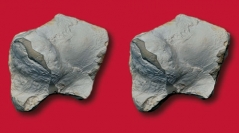

 Geodiversitas
44 (30) - Pages 933-973
Geodiversitas
44 (30) - Pages 933-973A basal member of Balaenomorpha (Cetacea, Mysticeti), Persufflatius renefraaijeni, n. gen., n. sp., is described based on cranial material discovered in upper Miocene deposits of Liessel (the Netherlands). Thanks to the palynological analysis of an associated sediment sample, the specimen is dated from the late Tortonian (Dinozone SNS M14: c. 8.2-7.6 Ma). Our phylogenetic analysis recovers the new taxon at the base of the successful crown mysticete clade leading to modern rorquals. Though the holotype is only partially preserved (it consists of the partial right side of the neurocranium), it provides new data on the cranial anatomy of these early relatives of extant rorquals, which are poorly represented in the global fossil record. Several skull parts (postglenoid process of the squamosal, base of the zygomatic process of the squamosal, the anteromedioventral portion of the squamosal bone, and the exoccipital) show unusual swelling due to pachyostosis, giving the whole lateral basicranial region an inflated aspect.
Tortonian, Liessel, the Netherlands, early Balaenomorpha, phylogeny, rorqual lineage, pachyostosis, cranial endocast, new genus, new species